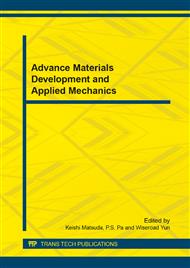p.72
p.78
p.84
p.89
p.95
p.99
p.103
p.109
p.113
The Microstructure and Mechanical Properties Research of FeCrWMoV-Series High Temperature Self-Compensation Lubricating Composite Materials
Abstract:
High temperature self-compensation lubricating composite materials were fabricated by vacuum sintering method in this work. The FeCrWMoV alloy powder was used as the basic material, the TiC and Co ceramic powder was used as reinforcing material and TiH2 and CaCO3 was used as pore-forming material. The changes of the crushing strength, micro-hardness and porosity were analyzed with the temperature. The pore structure and surface morphology of the preforms were analyzed using scanning electron microscope (SEM). The conclusion is that the most appropriate sintering temperature is 1250oC in the process of sintering, and the formation of secondary organization has significant influence on the properties of composite materials.
Info:
Periodical:
Pages:
95-98
Citation:
Online since:
July 2014
Authors:
Keywords:
Price:
Сopyright:
© 2014 Trans Tech Publications Ltd. All Rights Reserved
Share:
Citation:


